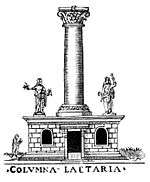Columna Lactaria

The Columna Lactaria ("Milk Column") was a landmark in ancient Rome in the Forum Holitorium, or produce market. The Roman grammarian Festus says it was so called "because they would bring babies there to be fed with milk."[1] It seems to have been a public charity where poor parents could obtain milk for their infants,[2] or a central site for locating and hiring wet nurses.[3] It has also been interpreted as a sanctioned site of child abandonment, where parents unable or unwilling to care for newborns could leave the child in the hope that it might be pitied and fostered (that is, given milk).[4]
The Columna Lactaria was located close to the Temple of Pietas, which displayed a painting on the theme of Caritas Romana ("Roman Charity"), about a woman giving breastmilk to an aged parent.[5] The column was probably destroyed by the construction of the Theater of Marcellus, beginning in the 40s BC.[6] One of the neighborhoods razed for the construction of the theater was the Vicus Sobrius, where the residents offered libations of milk to a Punic god Romanized as Mercurius Sobrius. This community may have maintained the Columna Lactaria;[7] Robert E.A. Palmer thought that the milk-offerings of Punic cult might shed light on the significance of the column.[8] Into the early 20th century, the piazza Montanara adjacent to the theater continued to be a place where wet nurses could be sought for hire.[9]
References
- ↑ Infantes lacte alendos deferebant: Paulus ex Festo 105 in the edition of Lindsay = Müller (88) p. 118, as cited by Mary Beagon, The Elder Pliny on the Human Animal: Natural History Book 7 (Oxford University Press, 2005), p. 314 online; Lawrence Richardson, A New Topographical Dictionary of Ancient Rome (Johns Hopkins University Press, 1992), p. 94 online.
- ↑ Beagon, The Elder Pliny on the Human Animal, p. 314.
- ↑ Suzanne Dixon, Childhood, Class and Kin in the Roman World (Routledge, 2001), p. 62 online; Keith R. Bradley, "Wet-nursing at Rome: A Study in Social Relations," in The Family in Ancient Rome: New Perspectives (Cornell University Press, 1986), p. 214 online.
- ↑ Richardson, A New Topographical Dictionary, p. 94; Arthur H. Shapiro, Everybody Belongs: Changing Negative Attitudes toward Classmates with Disabilities (Routlege, 1999, 2000), p. 172 online, with a great deal of recasting of the evidence to suit the book's stated purpose.
- ↑ Beagon, The Elder Pliny on the Human Animal, p. 314 online.
- ↑ Robert E.A. Palmer, Carthage and Rome at Peace (Franz Steiner, 1997), p. 102.
- ↑ John Bert Lott, The Neighborhoods of Augustan Rome (Cambridge University Press, 2004), pp. 11–12 online.
- ↑ Palmer, Rome and Carthage at Peace, p. 102.
- ↑ Mario Torelli, Typology and Structure of Roman Historical Reliefs (University of Michigan Press, 1992), p. 116 online. Richardson, A New Topographical Dictionary, p. 94, discounts the meaning of any association of the "Milk Column" with the Caritas Romana story, but see also Palmer, Carthage and Rome at Peace, p. 98, note 98 online.